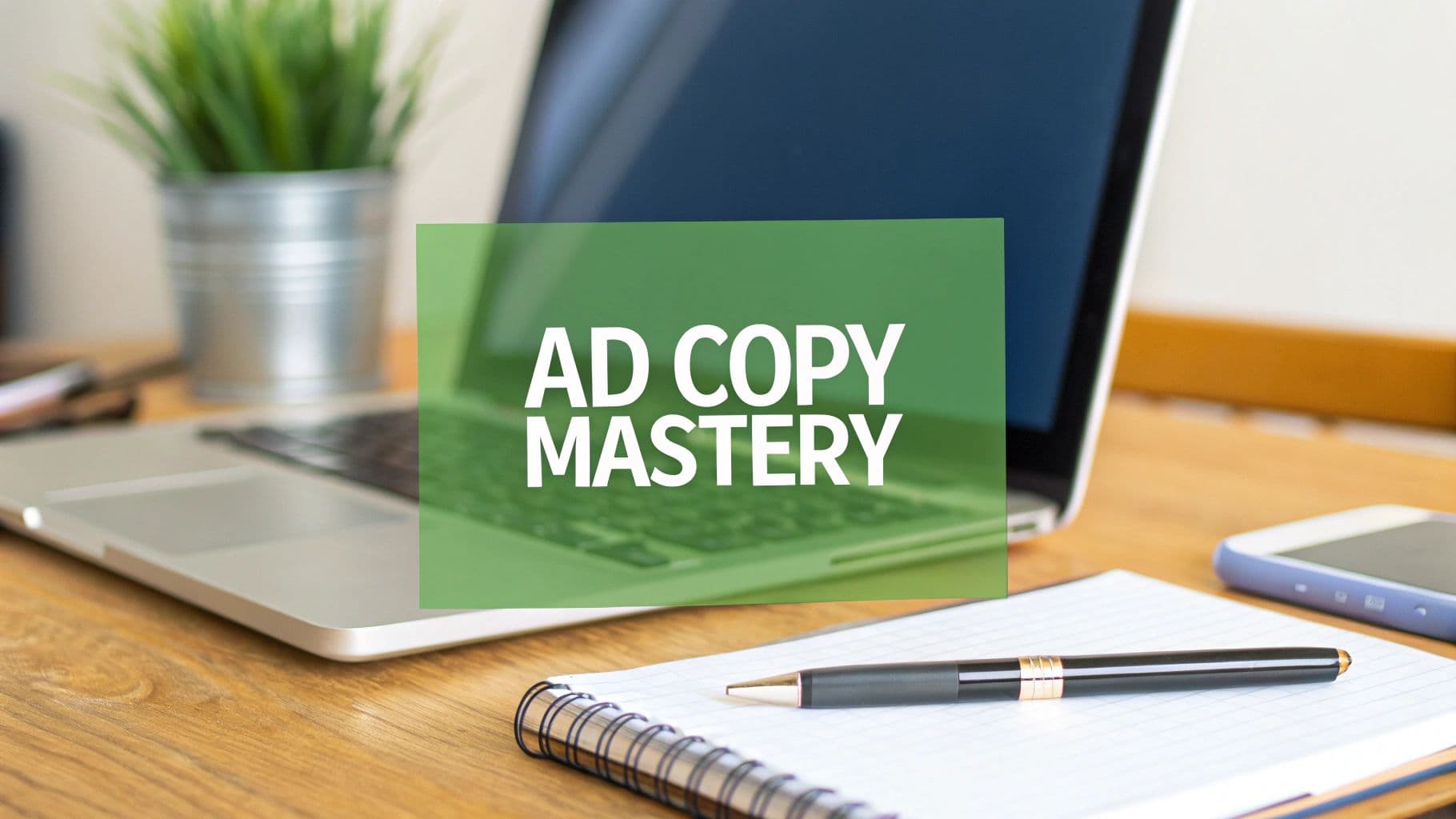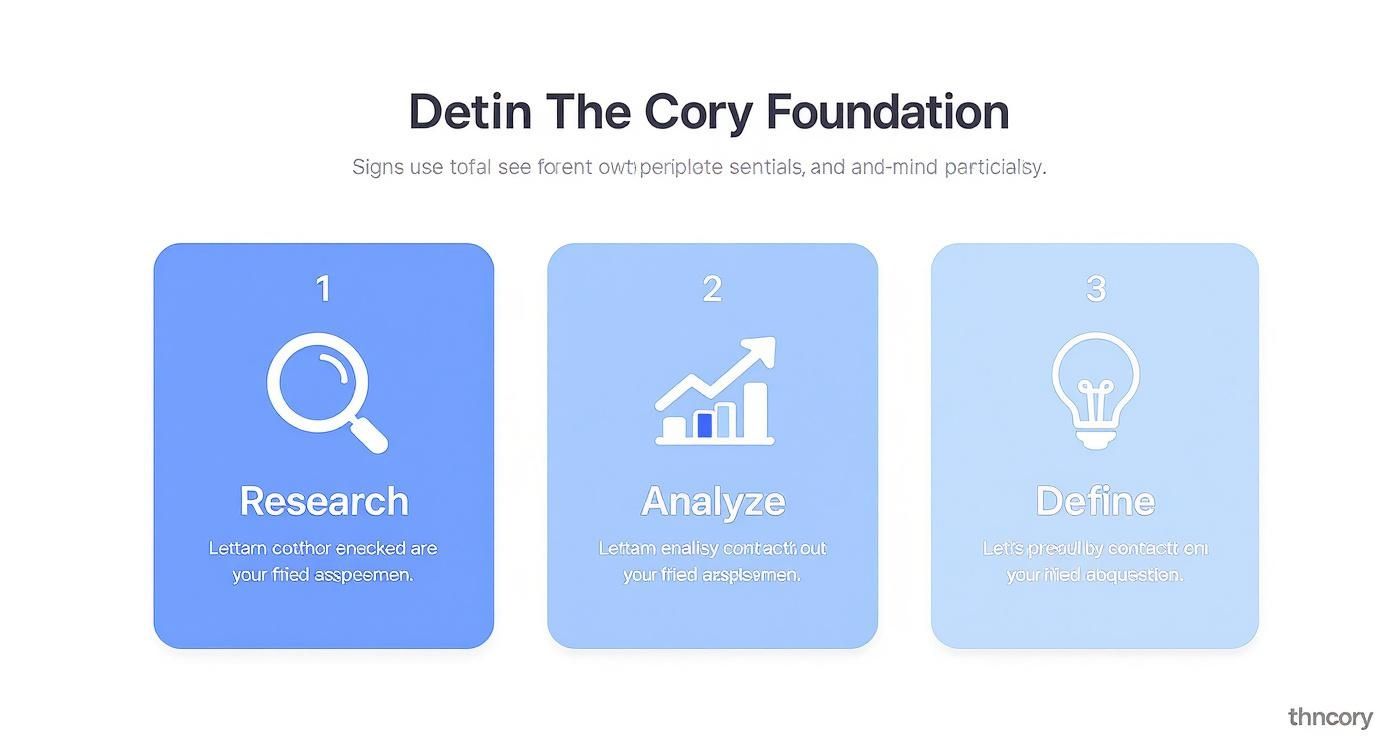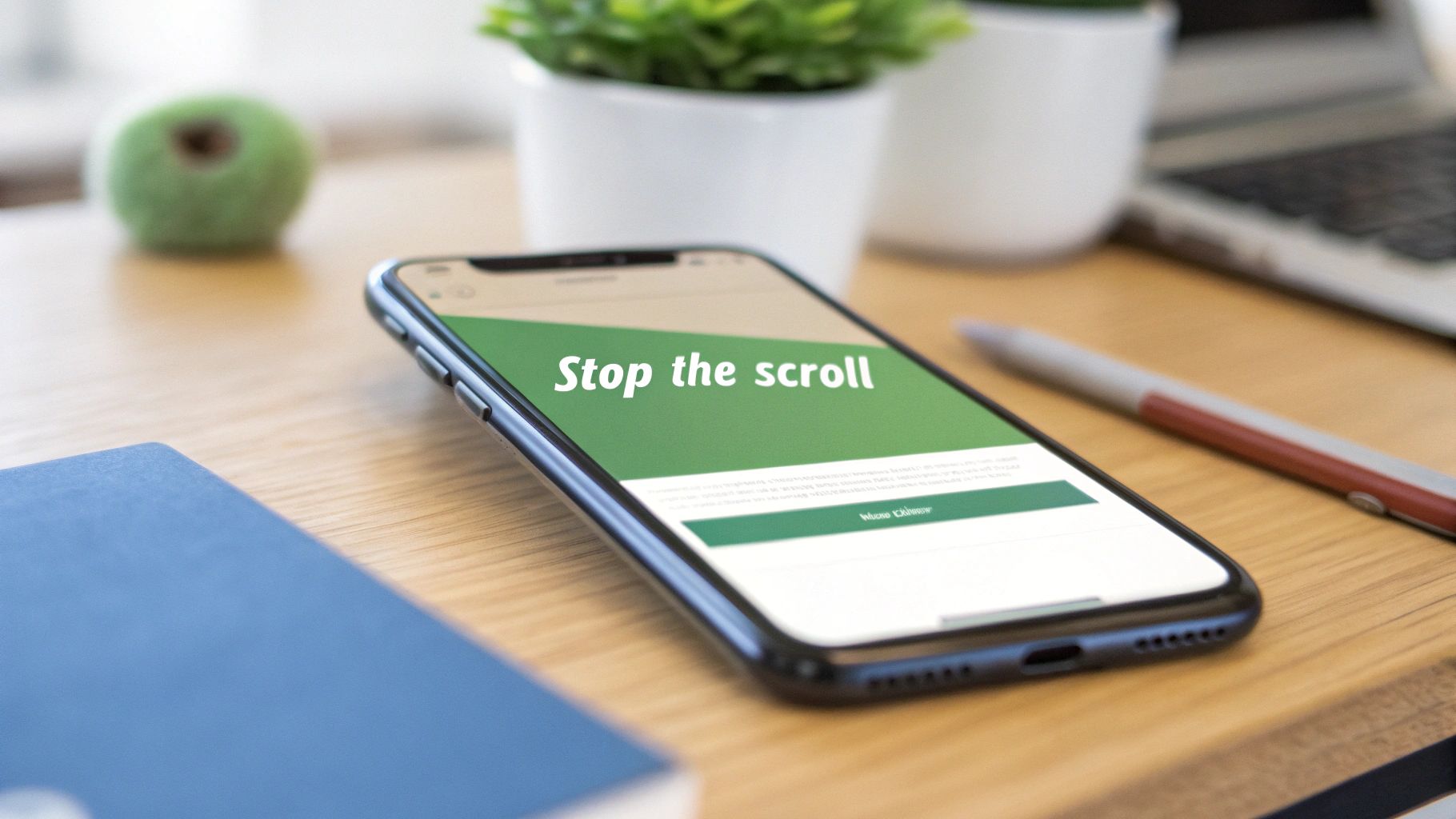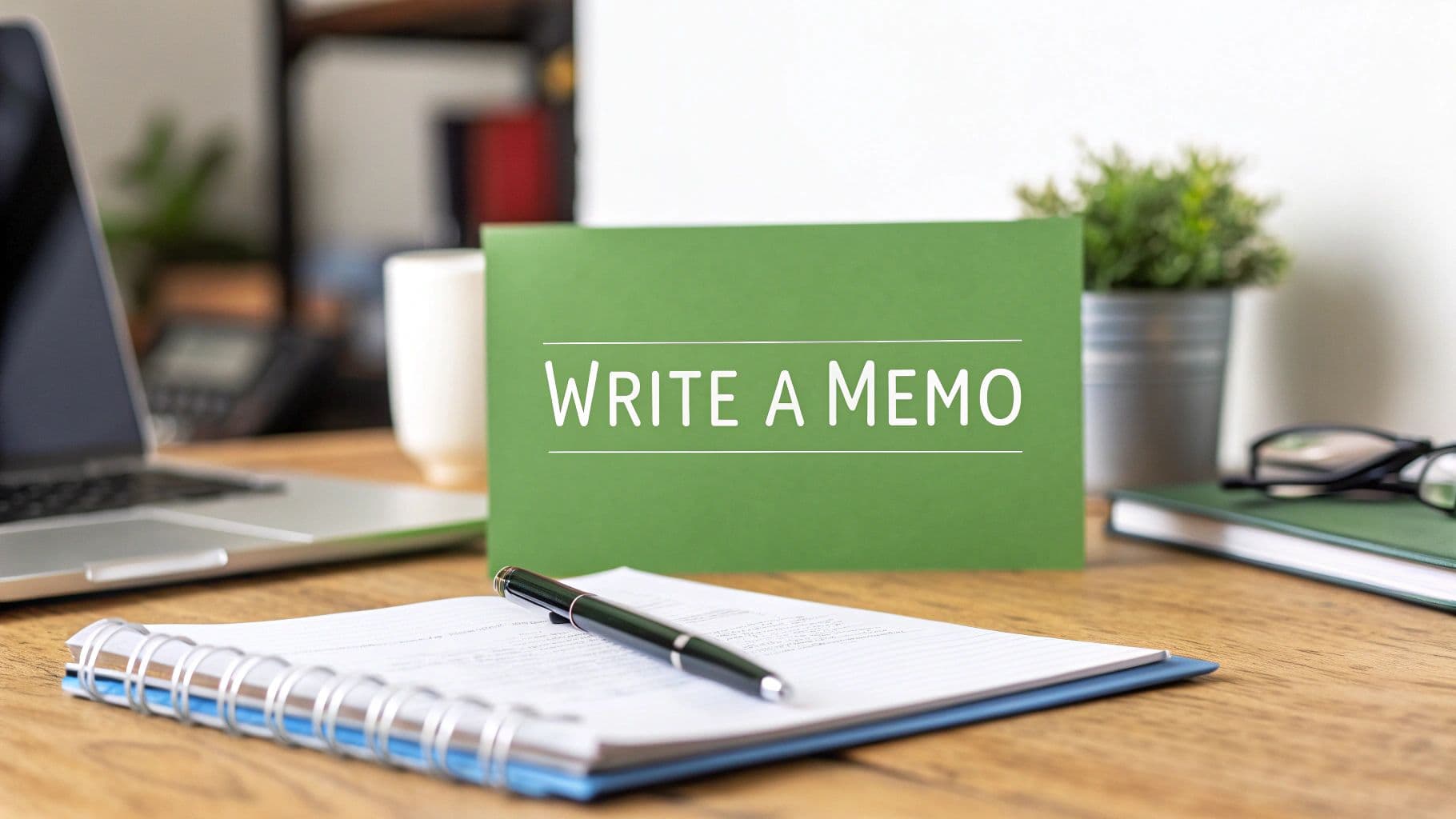
How to Write Ad Copy That Actually Converts
November 10, 2025
Great ad copy isn't about clever wordplay or flashy taglines. It’s about getting inside your audience's head, understanding their biggest headaches, and showing them you have the exact solution they’ve been looking for. It's a mix of psychology, strategy, and creativity, all packed into a few seconds to stop the scroll and get a click.
Build Your Foundation Before You Write
Too many people just open a blank document and start writing. That's a surefire way to end up with generic ads that nobody notices. The best, most magnetic ads aren't born from a random stroke of genius; they’re built on a solid foundation of research and a crystal-clear picture of the customer.
This is the real work—the part you do before writing a single word. It's where you dig up the insights that make your copy connect on an emotional level. It's about knowing your audience better than they know themselves. If you want to go deeper on this, we've got a great guide on what is audience analysis. Getting this groundwork right makes the creative part faster and a whole lot more effective.
Define Your Unique Value Proposition
First things first: you have to know what makes you different. What's the one big promise you make to your customers? That’s your unique value proposition (UVP). It's the single reason someone should pick you over all the other options.
To nail this down, ask yourself a few simple questions:
- What specific problem do we solve better than anyone else?
- What’s the most powerful benefit our customers get from us?
- Why should our ideal customer actually trust us?
Answering these gives you the core message that will anchor all of your ad copy.

This process isn't just a bunch of busywork. It’s a straight line from research to a powerful message. Skip it, and your ads will feel aimless and easy to ignore.
Analyze Competitor Messaging
You can’t win the game if you don’t know who you’re playing against. Before you write anything, you need to see what your competitors are doing. The goal isn't to copy them, but to spot what they're missing. A fantastic tool for this is the Facebook Ad Library: Your Secret Weapon For Ad Copy Inspiration—it's a goldmine of real-world examples.
Look for the gaps. If all your competitors are shouting about features, you can stand out by focusing on emotional outcomes and real-world benefits. Find their blind spot and make it your sweet spot.
This stuff matters. The global copywriting market is expected to hit USD 42.83 billion by 2030. Why? Because in a sea of digital noise, strategic and well-researched copy is the only thing that cuts through. This strategic groundwork ensures every word you write has a purpose.
Write Headlines That Stop the Scroll
Your headline is everything. It’s the gatekeeper to the rest of your ad.
You’ve got just a few seconds to hook someone before their thumb keeps moving, and if your headline fails, so does the rest of your beautifully crafted ad. The body copy, the call to action… none of it will ever be seen.
Think of it like an email subject line. If it doesn’t create a little curiosity or promise a real solution, that email is never getting opened. The same psychology is at play here. In fact, if you want some extra inspiration, many of the same ideas from our guide on email subject line best practices can be adapted for ad headlines.

Address the Reader's Core Problem
The quickest way to get someone to stop and listen is to prove you get their struggle. Vague, generic headlines get scrolled past. Headlines that nail a specific problem make your reader feel seen.
So, instead of a bland headline like "High-Quality Project Management Software," hit them where it hurts: "Tired of Missed Deadlines? Get Your Team Back on Track." See the difference? The second one connects with a real, painful frustration and immediately offers a way out. It shifts the focus from your product to their problem.
Your headline shouldn't be about what you sell; it should be about the problem you solve. Frame the reader as the hero of the story and your product as the tool that helps them win.
This works because you’re tapping into a basic human need: the search for a solution. When you mirror their pain point right back at them, you build an instant connection and signal that your ad has the answer they've been looking for.
Use Compelling Data and Specificity
Numbers are your best friend. They slice through the noise, make your claims feel real, and give your promises a backbone. Anyone can make a vague promise, but a data-backed headline is hard to ignore.
Just look at the difference:
- Vague: "Improve Your Team's Productivity"
- Specific: "How We Helped a 10-Person Team Save 15 Hours a Week"
The second one is so much more powerful, right? It uses a concrete number (15 hours) and a scenario that feels real (a 10-person team) to paint a vivid picture of the benefit. That specificity doesn't just grab attention; it builds trust.
This is especially true on crowded platforms where every click counts. If you want to dig deeper, check out these strategies to improve your Amazon CTR, where your headline can make or break a campaign.
Craft a Compelling and Persuasive Ad Body
So, your headline did its job—it stopped the scroll. Fantastic. But now the real work begins. The ad body has to deliver on the promise your headline just made, guiding someone from casual curiosity to genuine interest.
This is your space to expand on the core message. While a great headline earns you a few seconds of attention, the body copy is what earns the click. It’s the persuasive engine of your ad.

Speak to Benefits, Not Just Features
This is one of the oldest rules in copywriting, and for good reason—it’s also the most common mistake I see people make. No one buys a drill because they want a drill; they buy it for the hole it creates. Your customers don’t really care about your product’s technical specs. They care about what it will do for them.
You have to be the one to translate your features into their tangible benefits.
Feature: Our software has AI-powered scheduling.
Benefit: Stop wasting hours in your calendar and finally reclaim your afternoons.
Feature: Our mattresses are built with advanced memory foam.
Benefit: Wake up without that nagging back pain and feel truly rested for once.
Focusing on the benefit immediately answers the reader's unspoken question: "What's in it for me?" It shifts the story from being about your product to being about their improved life, which is a much easier sell.
The best ad copy makes the customer the hero. Your product is just the tool that helps them solve a problem and win the day.
This approach builds a much stronger emotional connection and is a true cornerstone of effective copy. To really get this right, you have to understand the psychology of why people buy, a topic we dig into in our guide on persuasive writing techniques.
Weave in Social Proof to Build Trust
Let's be honest: skepticism is the default setting online. Your audience has been burned by over-the-top promises before, so they’re naturally on guard. Social proof is your antidote to that doubt. It's real-world evidence from other people that your offer is legitimate.
You can work social proof into your ads in a few powerful ways:
- Customer Quotes: A short, impactful testimonial goes a long way. "This tool saved our team 20 hours a week" is infinitely more credible coming from a customer than from you.
- Key Statistics: Numbers create instant authority. Phrases like "Trusted by over 10,000 businesses" or "Rated 4.9/5 stars by 500+ users" provide a quick, scannable dose of validation.
- Trust Badges: Mentioning a high-profile client or an award lends immediate credibility. Think "As seen in Forbes" or "Used by the team at Google." It’s borrowed authority, and it works.
Social proof taps into a basic human instinct—we trust what others already trust. When a potential customer sees that others have had a great experience, it lowers their sense of risk and makes them far more comfortable taking that next step. It’s a simple but incredibly effective way to make your ad body more persuasive.
Create a Call to Action That Gets Clicks
You can write the most persuasive ad in the world, but it's all for nothing if your final command falls flat. The call to action (CTA) is that critical bridge between a reader's interest and your conversion goal. A weak CTA just creates friction and doubt. A strong one makes the next step feel like the most natural, obvious choice they could make.
The secret is to ditch vague, passive phrases. "Learn More" or "Submit" are dead on arrival—they have no energy and don't tell the user what they actually get. Instead, your CTA needs to be specific, packed with value, and built around a clear action.
Use Verbs That Convey Value
Strong CTAs almost always kick off with a powerful verb. But instead of a generic command, pick a verb that hints at a positive outcome for the user. What do they stand to gain by clicking that button?
Look at how a simple verb change can completely transform the offer:
- Instead of "Download," try "Get Your Free Guide."
- Instead of "Sign Up," use "Start My Free Trial."
- Instead of "Contact Us," try "Request a Custom Quote."
Each of these examples tells the user exactly what to expect and frames it as a clear benefit. They aren't just completing a task; they're taking action to get something valuable in return. That subtle shift in language makes the click so much more enticing.
Your CTA isn't just a button—it's the climax of your ad's story. It should feel less like an instruction and more like an invitation to solve their problem right now.
The internet is a noisy place. Since commercial internet access first kicked off in 1995, we've seen an explosion to roughly 4.62 billion indexed web pages and 347.3 billion emails sent every single day. To cut through that noise, your CTA has to be surgically precise and impossible to misunderstand. You can get a deeper dive into how this competitive environment is shaping copywriting in this 2025 State of the Industry report.
Match the CTA to the Buyer’s Journey
One of the most common mistakes I see is asking for too much, too soon. A user who just discovered your brand five seconds ago is not going to "Buy Now." Your CTA has to meet them where they are in their decision-making process.
Awareness Stage: At this point, they're just figuring out they have a problem. Your job is to educate, not to close a sale. CTAs like "Download the eBook" or "Watch the Webinar" are perfect here.
Consideration Stage: Now, they're actively looking at different solutions. You can be a bit more direct. Think "Get a Free Demo" or "See Pricing Plans."
Decision Stage: They're ready to pull the trigger. This is where you can use those high-commitment CTAs like "Start Your 30-Day Trial" or "Claim Your 20% Discount."
When you match your ask to their intent, you remove the friction and guide them smoothly down the path to becoming a customer.
Don't Be That Marketer: Adapt Your Copy to the Platform
The most amazing ad copy on Earth will absolutely bomb if it's running in the wrong place. An ad that kills it on Google Search is going to feel jarring and out of place in a TikTok feed. It's just a different world.
Every platform has its own vibe, its own unwritten rules, and its own user expectations. Learning how to write copy that feels native to each environment isn't just a nice-to-have. It's everything.
Think about it like this: you wouldn't talk to your boss the same way you talk to your best friend, right? Your ad's tone, length, and style have to adapt to their surroundings. This is what separates the campaigns that just run from the ones that actually deliver a return.

Writing for Google Ads: The Intent Machine
When someone is on Google, you have a secret weapon: you already know what they want. Their search query is a direct line into their brain. Your only job is to mirror that intent back to them with an ad that's clear, direct, and packed with the right keywords.
- Be a Mirror: If they search for "employee scheduling software," your headline had better be something like "The Best Employee Scheduling Software." No need to get cute.
- Focus on Solutions: Space is brutally tight. Headlines are limited to just 30 characters. There is zero room for fluff. Get straight to the point and hammer home the main benefit.
- Get Specific: Vague ads are invisible. Instead of a weak promise like "Save Time," hit them with "Save 10 Hours a Week." Numbers and specifics build credibility in a heartbeat.
The goal here is to create a dead-simple path from their search to your landing page. They're on a mission, and your ad needs to be the clearest signpost they see.
Engaging on Facebook and Instagram: The Social Sphere
Okay, let's flip the script. On Facebook and Instagram, nobody is actively searching for your product. They’re scrolling to see what their friends are up to, watch funny videos, and kill some time. Your ad has to feel less like an ad and more like a post from a friend.
The goal on social media is to interrupt a pattern of passive scrolling. Your ad needs to earn its place in the feed by being relatable, visually appealing, and emotionally resonant.
This is where a more conversational, story-driven approach shines. You have more space to build a narrative, connect with their pain points on a human level, and use a friendly, authentic voice. Use emojis. Ask questions. Encourage them to comment.
Just remember, you’re a guest at their party—don’t be the person shouting a sales pitch from the corner of the room.
Connecting on LinkedIn: The Professional Network
LinkedIn is a whole different beast. People are here with their work hats on. They're focused on career growth, industry news, and finding business solutions. Your ad copy has to respect that context.
- Speak with Authority: Drop the casual tone. Use professional language that builds your credibility. This is the place for data, industry expertise, and tangible business outcomes.
- Offer Real Value: LinkedIn users are looking for resources to help them do their jobs better. Your ad should feel like a resource, not a sales pitch. Offer a whitepaper, a webinar, or a free guide.
- Focus on the ROI: The decision-makers on LinkedIn are constantly thinking about return on investment. Your copy needs to spell out exactly how you'll save them money, boost their team's efficiency, or drive more revenue.
Tailoring your message for each platform ensures you’re not just shouting into the void. You're meeting your audience where they are, speaking their language, and delivering something they might actually want to see.
Common Ad Copy Questions, Answered
Even when you've got the basics down, you're going to hit a few roadblocks when it's time to actually sit down and write. It happens to everyone. Let's walk through some of the most common questions that pop up, so you can get past those hurdles and launch your ads with confidence.
Getting these right matters more than ever. The industry is always in motion, and with around 59% of copywriters now working freelance, the pressure is on to deliver sharp, creative messaging that actually works. This isn't just about writing—it's about strategic thinking that a robot can't just spit out. If you're curious, Blogging Wizard has some great stats on this.
How Long Should My Ad Copy Be?
Ah, the million-dollar question. The honest answer? There’s no magic number. The real rule is simple: be as long as you need to be to make your case, but as short as you possibly can to keep people from scrolling away.
It really comes down to the platform and your offer.
- Google Search Ads: You're forced to be brief here. With headlines capped at 30 characters, every single letter counts.
- Facebook & Instagram: You’ve got more room to breathe. For more complex products or services that require a bigger commitment, longer, story-driven copy can be a game-changer. It gives you the space to build trust and really dig into the benefits.
When in doubt, test it out. Seriously. Run a short, punchy version against a longer, more descriptive one. The data will tell you what your audience actually wants to see.
How Can I Use AI to Write Better Ad Copy?
Think of AI as your super-smart brainstorming partner, not as a replacement for your brain. It's a fantastic tool for getting unstuck and speeding things up, but it shouldn't be the final author.
Here's where it really shines:
- Generating a dozen headline ideas in seconds.
- Reframing your core benefits from a few different angles.
- Turning customer reviews into short, powerful snippets of social proof.
The best way to work with AI is to feed it a rich, detailed brief. Tell it about your audience, your brand voice, and your offer. Then, take what it gives you and inject your own empathy, creativity, and unique personality. Never just copy and paste.
What Is the Biggest Mistake in Ad Copywriting?
Easy. Focusing on features instead of benefits. It's the most common—and most costly—mistake you can make.
You're proud of your product's specs ("10GB of cloud storage!"), and you should be. But your customers don't buy features. They buy what those features do for them. They buy the solution, the feeling, the outcome. In this case, the benefit is: "Never worry about losing a precious photo again."
Always, always ask yourself, "So what?" for every feature you list.
- Feature: Our CRM integrates with your email.
- "So what?" (Benefit): So you can stop flipping between tabs and manage all your customer conversations in one place, saving you hours every week.
Mastering this simple shift—from what your product is to what it means for your customer—will completely change your ad performance.
Ready to turn your AI drafts into compelling copy that actually converts? Natural Write instantly refines robotic text, making sure your message is clear, engaging, and sounds 100% human. Perfect your ad copy, blog posts, and emails with a single click.


